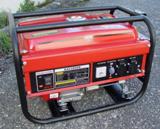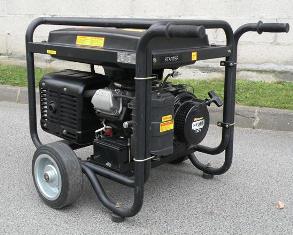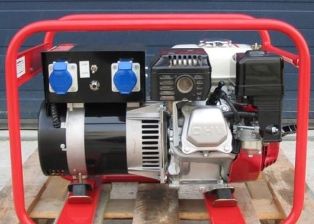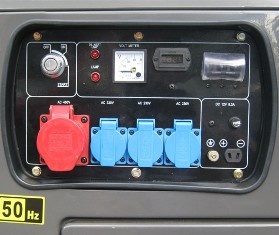Maintenance of generators in mobile power plants
 When carrying out technical maintenance of generators of mobile power plants, the following works are carried out:
When carrying out technical maintenance of generators of mobile power plants, the following works are carried out:
1. Clean the generator housing and exciter of dust and dirt with compressed air or cleaning material. Traces of oil are removed with a cleaning cloth soaked in gasoline.
2. Check the tightness of the bolts and nuts securing the generator to the frame. Loose bolts and nuts are tightened.
3. Check the reliability of the grounding of the generator case and the switchboard. Contacts with traces of corrosion are disassembled, cleaned to a metallic shine with sandpaper or a file with a fine notch, lubricated with technical petroleum jelly, assembled and tightened. The integrity of the ground wire or busbar is checked by inspection.
4. Remove the covers from the inspection and maintenance windows of the brush mechanism or rectifier. The mechanism or block is blown with compressed air.
Depending on the construction of the generator (with exciters, with selenium, silicon or mechanical rectifiers), the following is checked: the condition of the traverses and the absence of cracks and insulation damage on their surface, the condition of the brushes and their adhesion to the slip rings or to the collector. The working surface of the brushes must be smooth and shiny, the brushes must not have chips or cuts.
Worn or damaged brushes are replaced with new ones of the same brand. The simultaneous use of brushes of different brands is unacceptable, because due to uneven electrical conductivity and different transition resistance, the current distribution between the brushes will be uneven, the commutation of the generator will be disturbed and it may be damaged.
If it is necessary to replace the brushes and there are no factory installed brushes of the brand, then all brushes of the generator are replaced with new ones of the same brand. Check the condition of the brush mechanism springs with a dynamometer. Weakened springs are tightened, and damaged ones are replaced with new ones.

5. Check the condition of the contact connections of the generator and exciter terminals, as well as the condition of the terminal box parts.
By external examination, ensure that there is no insulation, cracks and burn marks on the insulation panels of the terminal boxes.
Carefully check the integrity of the insulation of the generator terminals and wires connected to the generator and exciter terminals. Insulation areas with cracks, mechanical damage, delamination or charring are insulated with cotton or PVC insulation tape.
Depending on the design of the boxes, the condition of the contact connections is checked with keys or a screwdriver.Loose contacts are tightened, and oxidized, burnt or darkened contacts are disassembled, the contact surfaces are cleaned to a metallic shine, assembled and tightened.
6. For generators with rectifiers, manually stagger to check contact washer pressure and condition of rectifier attachment. Check the soldering places of the wires to the contact terminals of the rectifiers. In case of partial or complete destruction of the contact, it is soldered again. Soldering of wires using acids is not allowed.

7. Check the collector, slip rings or spacer ring of the mechanical rectifier. In case of contamination or darkening, their surfaces are wiped with a cleaning material soaked in gasoline. If necessary, the surfaces are polished with fine sandpaper.
eight. For generators that have worked for more than 500 — 600 hours from the moment of their commissioning, maintenance or technical support, in which the lubricant was changed, the condition of the bearings is determined by inspection, after removing their covers. Top up or change the lubricant if necessary. Changing the grease in generator bearings is similar to changing the grease in electric motor bearings.
For generators with journal bearings, the oil in the bearings is changed every 2 to 3 months. To do this, the old oil is released, the bearing is washed with gasoline with the addition of 10% oil and a new one is poured.
9. Make sure that the rotating parts do not touch the stationary parts by turning the generator armature by hand or using the lever.
10. Check the condition of the clutch between the generator and the drive motor.Particular attention is paid to the connecting elements.
In mobile power plants of low and medium power (up to 50 kV-A), the condition of the rubber connecting plate is checked by inspection. In the case of power plants with greater power, the condition of the rubber bushings of the connecting pins is checked. The rubber plate and bushings must not be damaged or cracked.
If an external inspection cannot determine the condition of the plate or bushings, check the amount of free movement of the clutch half fixed to the generator shaft relative to the clutch half fixed to the motor shaft.
To do this, the generator shaft is turned slowly by hand or lever until the fingers of the coupling half with rubber bushings touch the walls of the holes of the second coupling half. In this position, a straight line is drawn on the surface of the connector half along the generating line with a pencil or chalk.
The generator shaft is then slowly rotated in the opposite direction, also until the fingers meet the walls of the coupling half. The distance that forms between the drawn lines will indicate the amount of free movement and wear of the clutch on the rubber plate or bushings.
In case of severe wear, the plate or rings are replaced with new ones.
If the generator is connected to the drive motor by a belt or V-type transmission, check the tension of the belts and, if necessary, increase their tension using the adjusting bolts.
11. Check the operation of the generator at idle, for which the drive motor is turned on and its speed is brought to the rated speed.
When the generator is running, no extraneous noise and knocking should be heard.
Note. After each external short circuit and protection, the generator is carefully checked and checked according to points 2, 3, 4, 5, 7, 9, 10.

